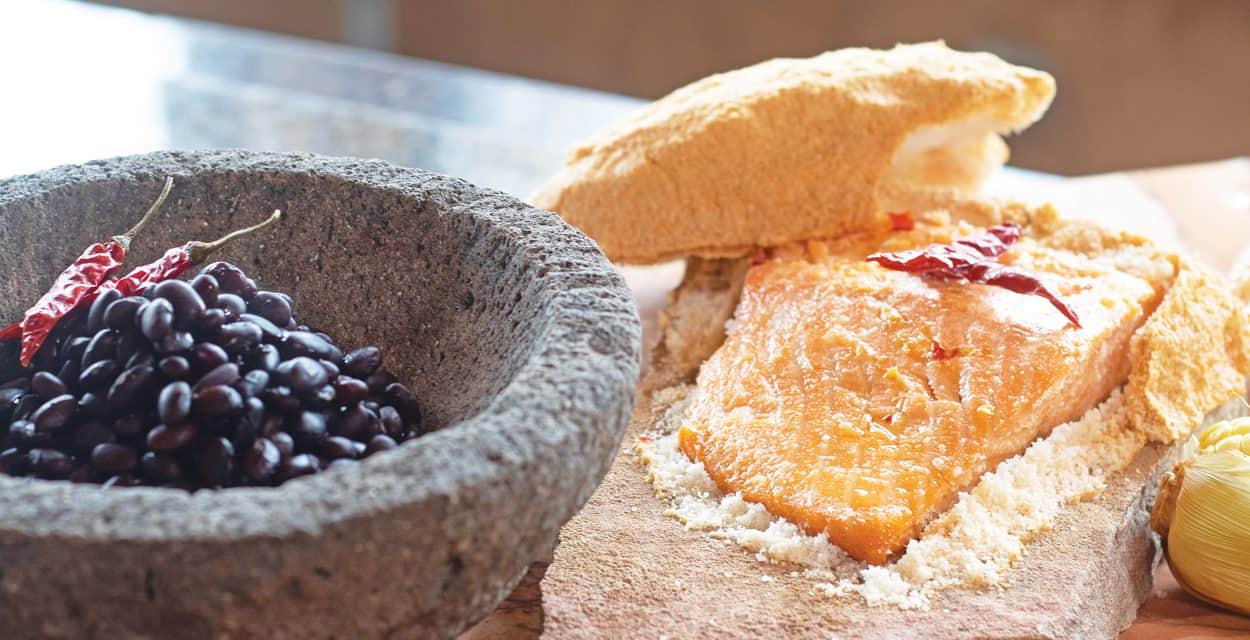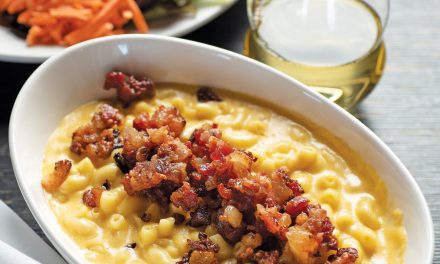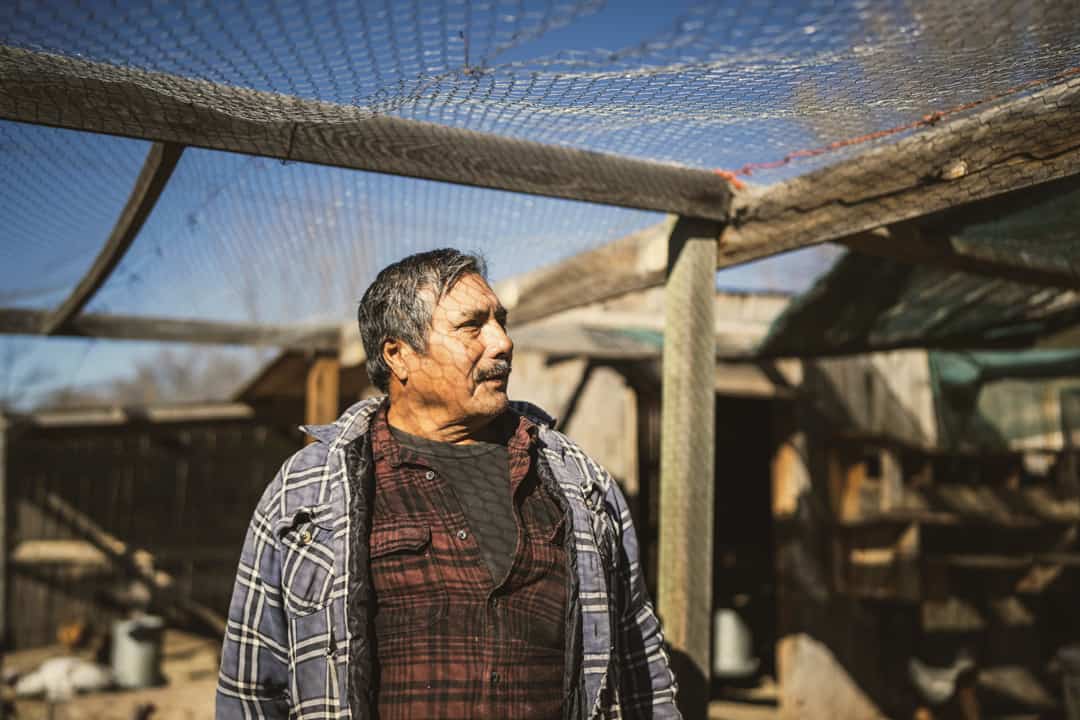Executive Chef, Indian Pueblo Cultural Center
Interview and Photos by Stephanie Cameron

Executive Chef Ray Naranjo is of Native American roots from the Ancestral Pueblos of the Southwest and the Three Fires tribes of the Great Lakes. He believes in preserving his people’s foodways and ancestral knowledge and strives to continue on this path. By using both modern and ancestral cooking techniques, he attempts to push the limits of what is known, unknown, and forgotten about the Indigenous food cultures of North America. In February, I sat down to talk with Naranjo about his current Pante Project and the future of the Indian Pueblo Kitchen at the Indian Pueblo Cultural Center (IPCC). The Pante Project is a take-out food pop-up, where Naranjo will craft a different monthly menu until the new space opens—and possibly beyond.
Before we talk about the future, what was your food-based upbringing like?
Growing up on the Santa Clara Pueblo in the 1980s, I watched cooking shows on PBS. I had a good imagination because even though we didn’t have the same food as what was on TV, I would pretend and make stuffed hamburgers and creative things like that. My mom was a single working mother, and there were four of us, so we had to fend for ourselves at times. We all learned traits to take care of the household, so my job was to cook because I hated to do dishes or clean.
Was there a moment that made you choose cooking as a career?
I guess when I was ten years old—instead of going on a hunting trip, I stayed back and cooked Thanksgiving dinner. My mom was a hunter because we were part of the hunter clan, and when they came back from the trip, I had created a big spread. I think that is when I knew.
I got my real inspiration when I was living in Arizona, and I saw the chef profession in a different and more respected way, and I realized I could cook for a living. I had two jobs, and both of them were in the kitchen—one at a regular restaurant and one in a hospital kitchen. I saved my money, and when I finished high school, I checked out different culinary programs and ended up choosing the Le Cordon Bleu program. And that’s when I decided cooking was a good fit.
What was your path to IPCC?
I worked in executive chef positions at casinos in northern New Mexico for about ten years while I was in my twenties. I helped open Buffalo Thunder in 2008, and this was the first job where I felt like I was working with professionals who were on another level. That’s when I felt like I needed to go back to school. I took engineering and business classes, and while I was there, I ended up back in the kitchen. The program there had an organic farm, and they wanted a café. And I was like, Oh man; I could probably do that. And so it was cool. We got to go out and pick fresh vegetables that were grown by students, and then create a menu with them in the café. While I was at the school, my wife and I got pregnant with our fourth child, and I needed to get back to work, so I went to work at El Monte Sagrado in Taos.
While I was in school, I did the Pueblo Food Experience during the project phase [at Flowering Tree Permaculture Institute]. After the book, The Pueblo Food Experience Cookbook: Whole Food of Our Ancestors, came out, people wanted to experience the book’s food. The author, Roxanne Swentzell, wasn’t able to fulfill the requests for food experiences, so I started doing private catering events for people wanting to experience the food in the cookbook. I sustained myself for about four years just fulfilling people’s wanting to know more about the Pueblo experience. I took an executive chef position at Angel Fire Resort, and I said the only way I would do it is if they let me do an Indigenous menu. I did the fine dining restaurant there for a year, and then I applied here. So that’s the story.

Black beans and salt-crusted salmon cooked in the pante.
And so now that you’re here, how important is it that IPCC has an Indigenous chef at the helm of the Indian Pueblo Kitchen?
It’s a story that needs to be told; it’s a story that is missing from food history. It’s an important history because it influenced every single culture as far as ingredients go. I wish that part of our food history was taught at the culinary-school level because everything that I learned about Indigenous ingredients was self-taught.
Have you made any connections to other Indigenous chefs around the country?
It was an interesting journey doing the private chef stuff because I got to interact with many celebrities on a personal level. I got to do private events for Steven Spielberg, and then I did some private events for Heather Henson, the daughter of Jim Henson. We connected really well, and she flew me around and started introducing me to people. That’s when I ended up meeting Sean Sherman, The Sioux Chef, at an Indigenous food show. When I was working in Taos, I also got to spend time with Loretta Barrett Oden [known for her television series, Seasoned With Spirit: A Native Cook’s Journey, on PBS.]
The IPCC is reimagining the Pueblo Harvest Restaurant as the Indian Pueblo Kitchen, an innovative teaching kitchen and restaurant centered around Indigenous cuisine education and exploration. What will a class look like at the Indian Pueblo Kitchen?
We are trying to make it real-world focused. There will be hands-on experiences, not just classroom demos. An example is if you go to a cooking school and have this big demo thing going on; that’s not what you get when you go to a real job, so you want to have that hands-on environment as part of the teaching. We will use the garden that we have out here, the Resilience Garden, where we can harvest greens and then actually work with them in the kitchen instead of just talking about them. I think that’s very important.
Are the classes going to be curriculum-based versus one-off cooking classes?
We are working on accreditation that will be part of Central New Mexico Community College. And other program parts would be more practical-type stuff, like how to set up a food-based business with all the necessary steps. We also want to teach Indigenous cooking techniques and prepare students for careers in the hospitality industry.
While the Indian Pueblo Kitchen has been waiting to fully open, you have been doing the Pante Project. What have been some of your sources of inspiration for the Pante Project menu?
We are taught in the Tewa way, which is passed down from generation to generation, that when you start something, you should always begin with a prayer. So this [Pante Project] is like a prayer, and the way it’s set up . . . it’s like an offering. It starts with the north direction. With an actual table prayer, it would follow in that format where you would start with the north, and then you’d go to the west, south, and then east. The corn in the menu represents the direction as well, with the different colors—blue, red, yellow, and white—from a table perspective. If you’re in a different tribe, you’re probably going to have different colors; this is specifically from the Tewa perspective.
Talk a little bit about the technique of using the pante.
The technique itself is a tie-in of cultures. Pante means “bread house”—a combination of pan, the Spanish word for bread, and tewha, the Tewa word for house, which is the name by which these traditional clay ovens are called [also known as hornos].
It is the closest way to being in touch with the fire. As Pueblo people, I believe that we were a little more sophisticated in our ways and things that we did—it’s sort of a fancy way to use the fire. I wanted to incorporate live fire into what we are doing here in the [IPCC] kitchen.
It is a high cooking fire, so we’re cooking at 700°F. If we were to do a full service, it would get that hot at eight in the morning, but by the end of the night, it’s going to be 200–300°F, so you have to learn how to work with the oven as it cools down.
Have you used this fire cooking technique before?
Learning this technique also came along with the Pueblo Food Experience. I researched the past, present, and future for cooking with the live-fire method.
Of the meals you’ve created so far for the Pante Project, do you have a favorite?
We do a turkey tamale. We roast a whole turkey until it has a really nice bronze color on it, and then we cover it and let it steam with some water. Then we take all the juices that collected in the pan, and use that in the masa—it gives it this whole other really good flavor, and then we just add in some chiles. It’s basic and simple, but it’s so good at the same time.
We know that you’re going to have an education component of the Indian Pueblo Kitchen. Is the restaurant component going to be in a day-to-day restaurant where people who are visiting the IPCC can dine?
The restaurant will be an amenity to the museum; it will be a window of what’s happening in the modern Pueblo kitchen. It will include food trends you might see if you lived on the reservation today, like enchiladas and Kool-Aid pickles—things that are just accepted and the food norms of today.

Will the Pante Project continue after IPCC reopens?
This is just the beginning. Series two will be poeh, the path that you walk in Tewa. The path can break off into different parts so that I could take it in different directions. I wanted to leave it open so that I could focus on regions: I could say this is a taste of the high desert, or this is a taste of the alpine area. All these different regions and Pueblos have various sources and distinct flavors that will be my inspiration.
And will they continue to be a monthly offering?
I think when we reopen, we’ll spread them out and make them more exclusive, and people can attend in person. We will use the Indian Pueblo Kitchen space, and attendees can participate in the cooking experience and participate in making the meals.
In five years, if you are standing here, what does success look like, what do you want to accomplish?
When a book on Indigenous cuisine is acceptable to be taught at the university level. I want Native food to be recognized for its significant role in modern cuisine.
This interview was edited for length and clarity.
2401 12th St NW, Albuquerque, indianpueblo.org
Edible celebrates New Mexico's food culture, season by season. We believe that knowing where our food comes from is a powerful thing. With our high-quality, aesthetically pleasing and informative publication, we inspire readers to support and celebrate the growers, producers, chefs, beverage and food artisans, and other food professionals in our community.












